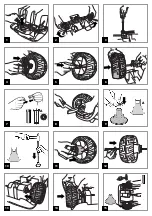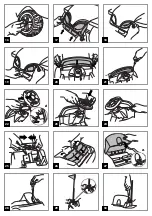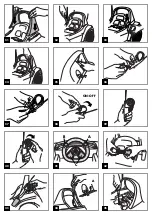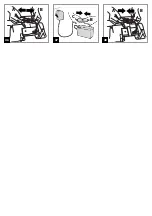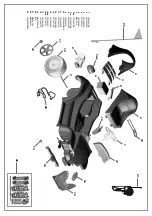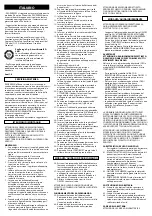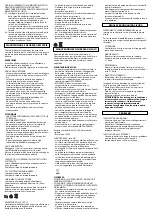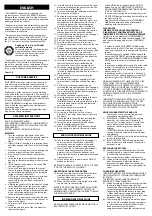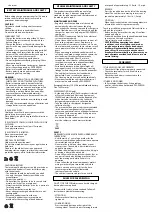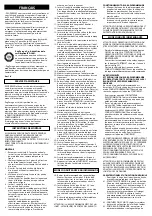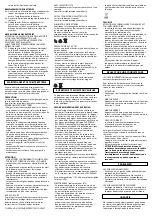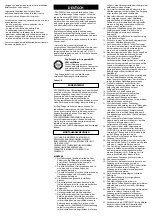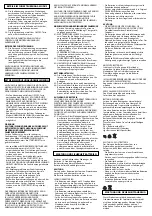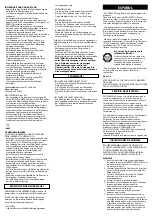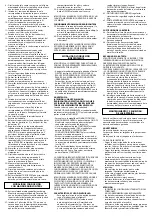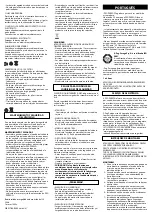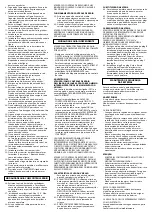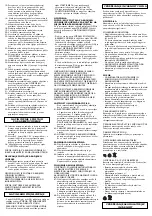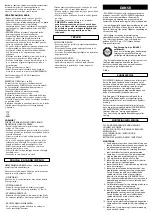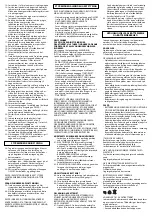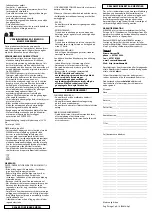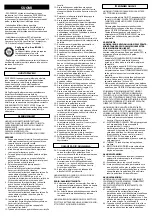
• PEG PEREGO® thanks you for choosing this
product. For over 50 years, PEG PEREGO has been
taking children for an outing: first with its famous
baby carriages and strollers, later with its pedal and
battery operated toy vehicles.
• Read this instruction manual carefully to learn the
use of this vehicle and to teach your child safe and
enjoyable driving. Please keep this manual for use
as a reference in the future.
• Our toys conform with the safety requirements
provided by the Council of the EEC, of the T.Ü.V.; of
the I.I.S.G. Istituto Italiano Sicurezza Giocattoli, and
the U.S. Consumer Toy Safety Specification F963.
Peg Perego S.p.A. is an ISO 9001
certified company.
The fact that we are certified provides
a guarantee of our honesty for our
customers, and fosters trust in the
company’s way of working.
• Peg Perego reserves the right to modify or change
their product. Price, literature, manufacturing
processes or locations or any combination of these
above mentioned entities may change at any time
for any reason without notice with impunity.
Years 1-4
PEG PEREGO offers after-sales services, directly or
with a network of authorized service centers for
repairs or replacement parts. See the back cover of
this instruction manual for a list of service centers.
Peg Perego is at the consumer's service, meeting
every need in the best way possible. This is why our
customers' opinions are so important and valuable
to us. We would be very grateful if you would kindly
fill in the CUSTOMER SATISFACTION
QUESTIONNAIRE after using one of our products.
You will find the questionnaire on the Internet at
"www.pegperego.com".
Please note any observations or suggestions you
may have on the questionnaire.
ADULT ASSEMBLY REQUIRED.
USE CARE WHEN UNPACKING AS COMPONENTS TO
BE ASSEMBLED MAY POSE A SMALL PARTS/SHARP
EDGE HAZARD.
BATTERY ALREADY INSTALLED IN VEHICLE.
ASSEMBLY
1 • Turn the vehicle upside down. In the front
section, insert the hole of the steering rod onto
the pin of the gear motor, as shown in the
figure.
2 • Slightly lift the 2 steering levers, rotating them
until they engage with the ends of the steering
rod.
3 • Attach the 2 steering levers to the steering rod
with the respective screws and washers.
4 • Press to snap fit the hub caps onto the four
wheels.
5 • Insert the respective small bushes into the
housing inside the two wheels, as shown in the
figure.
6 • Insert a washer and a wheel onto each of the
two steering levers.
7 • Insert a self-locking washer into the special
tool, as shown in the figure. Important, the tabs
on the self-locking washer must be facing the
inside of the tool (see detail A).
NOTE: spare self locking washers are included
in the bag and these should be carefully
conserved in case one breaks and requires
replacement.
8 • Holding the vehicle still, fix the wheel as shown
in the figure. Repeat for the other front wheel.
9 • Insert a self-locking washer into the special
tool, as shown in the figure. Important: the tabs
of the self locking washer must be facing the
inside of the tool (see detail A).
10 • Remove the grey protector caps from the ends
of the rear axle. Insert the axle into the tool, as
shown in the figure.
11 • Fully insert the 2 large bushes inside the
wheels.
12 • Insert the axle into one of the two wheels, as
shown in the figure.
ENGLISH
CUSTOMER SERVICE
ASSEMBLY INSTRUCTIONS
13 • Insert the unit into the rear of the vehicle (gear
motor side), engaging the gear motor into the
bush as shown in the figure.
14 • Insert a washer and the remaining wheel onto
the other end of the axle.
15 • Position the conical tool, which was used
previously, on the axle (gear motor side).
Making sure that the tool does not move, turn
the vehicle onto the gear motor side. Insert a
self locking washer into the remaining tool
provided and attach the wheel (see figure).
16 • Turn the vehicle back onto its wheels and fit
the four boss cover caps, making sure that the
teeth engage into the respective cavities.
17 • Fit the front mask, applying pressure to engage
it into its housing in the bodywork.
18 • Apply the transfers A and B.
19 • Press the front lights to snap them into place.
20 • Insert the windscreen into its three slots.
21 • Fasten the windscreen at the sides with the two
screws.
22 • Remove the protection cap from the steering
shaft and position the hole in the steering shaft
parallel to the windscreen. Connect the
steering wheel to the dashboard, as shown in
the figure. Insert the connected unit under the
steering wheel (see detail A).
23 • Insert the steering wheel onto the steering
shaft, taking care to insert the dashboard
spring into its cavity in the steering wheel.
24 • Fasten the steering wheel with the screw and
nut provided. IMPORTANT: the nut must be
inserted in the hexagonal hole and the screw in
the round hole.
25 • Connect the electrical system plug to the
vehicle battery.
26 • Position the seat support, engaging first the
two rear tabs (1) and then the two front tabs
(2).
27 • Put the seat in the required position by
inserting the two front tabs and then engaging
the rear tab (detail A). Important: the seat can
be set in three different positions according to
the height of the child.
28 • Fasten the seat down with the screw.
29 • Insert the aerial unit with its spring in the hole
in the bodywork, as shown in the figure.
IMPORTANT: check that the plate located in the
hole in the bodywork is visible and therefore
correctly inserted.
30 • Fasten it with the screw provided.
31 • Insert the roll-bar into its slots.
32 • Fasten the roll bar with 3 of the 4 screws
provided (2 rear and 1 front right), as shown in
the figure.
33 • Attach the radio control holder, inserting the
front tab into the slot in the bodywork.
34 • Fasten the radio control holder and roll bar
with the fourth screw provided.
35 • When the START/RESET button below the roll
bar to the right is pressed, the vehicle is ready
for use.
36 • Take the radio control out of its packaging. Fit
and screw on the aerial. With a screwdriver
remove the screw on the back of the radio
control and open the battery compartment.
37 • Insert 2 type AA 1.5 V batteries (not included)
into the compartment, ensuring that the
polarity is correct. When the batteries are in
place, close the battery compartment cover and
tighten the screw.
38 • Switch on the radio control with the ON/OFF
button on the back.
WARNING! THE RADIO CONTROL IS NOT A TOY. KEEP
IT OUT OF THE REACH OF CHILDREN!
OPERATION OF THE RADIO CONTROL
39 • Extend the radio control aerial. When the lever
is pushed downwards, the vehicle goes
forwards. When the lever is pushed upwards,
the vehicle goes backwards.
40 • When the central dial is turned right or left, the
vehicle turns in that direction.
IMPORTANT: WITH THE RADIO CONTROL SWITCHED
ON, MAKE SURE THAT IT OPERATES WITHIN THE
MINIMUM FIELD OF RECEPTION IN ORDER TO AVOID
THE VEHICLE STOPPING.
WARNING! INDEPENDENT DRIVE MODE MUST ONLY
BE ACTIVATED BY ADULTS.
RADIO CONTROL DRIVE MODE
INDEPENDENT DRIVE MODE
• Switch off the radio control with the ON/OFF
button (see fig. 38). IMPORTANT! THE VEHICLE
WILL NEVER ENTER INDEPENDENT DRIVE MODE IF
IT IS NOT SWITCHED OFF.
To activate the steering wheel controls, press the
START/RESET button located under the roll bar on
the right (see fig. 35).
Now the vehicle will operate in INDEPENDENT
DRIVE mode, with the option of immediate
stopping with the radio control.
PLEASE NOTE
IMPORTANT! WITH THE RADIO CONTROL
DISABLED, ANY CONTROL ACTIVATED ON IT
IMMEDIATELY STOPS ALL VEHICLE MOVEMENT.
In order to restart movement in INDEPENDENT
DRIVE mode, with the radio control disabled (OFF)
and the vehicle stopped, press the START/RESET
button.
• To return to the RADIO CONTROL DRIVE mode,
enable it with the ON-OFF button. First the vehicle
stops and it can then be controlled with the radio
control.
• If the radio control is enabled (ON) and the child
pushes the START/RESET button, the vehicle stops
moving WITHOUT ENTERING INDEPENDENT DRIVE
MODE, due to the priority of the enabled radio
control.
• To avoid any problems of reception from the radio
control, it is advisable to check that the aerial is
positioned correctly in its housing as described
above (see fig. 29).
• In both drive modes, if the vehicle is not used it
switches off after about 8 minutes in stand-by. To
reactivate it, press the START/RESET button.
NORMAL OPERATION OF THE PRODUCT CAN BE
AFFECTED BY STRONG ELECTROMAGNETIC
INTERFERENCE. IF THIS HAPPENS, FOLLOW THE
INSTRUCTIONS IN THIS MANUAL TO RESET THE ITEM
SO THAT IT RETURNS TO NORMAL OPERATING
CONDITIONS. IF THE VEHICLE DOES NOT RETURN TO
NORMAL OPERATION, USE IT IN A DIFFERENT
LOCATION.
IMPORTANT! THE RADIO CONTROL MUST NOT IN
ANY WAY BE CONSIDERED AS A SAFETY DEVICE
AND CANNOT IN ANY WAY REPLACE THE
SUPERVISION OF AN ADULT AND THE NEED TO BE
CLOSE TO THE TOY IN CASE OF DANGER.
VEHICLE CHARACTERISTICS AND USE
• To move the seat to the required position,
proceed as described in point 27.
41 • ELECTRONIC STEERING WHEEL: the steering
wheel has 2 drive buttons (A forward, B
reverse). The 2 orange buttons (C) with LEDs
start 8 melodies and if pushed together
produce 3 sounds (engine roar, horn and
braking).
• STOPPING: when the drive buttons on the
steering wheel are released, the vehicle stops
automatically.
42 • SAFETY BELTS: adjust the safety belts according
to the size of the child.
43 • RADIO CONTROL HOLDER: only replace the
radio control in its holder when the vehicle is
no longer in use.
REPLACING THE BATTERY
44 • Remove the screw behind the seat. Push the
seat locking tab to release it and allow access
to the battery compartment.
45 • Unscrew the battery holder and remove it.
46 • Disconnect the plugs by pressing them on the
sides. Remove and replace the battery.
Reconnect the plugs and screw the battery
holder back on. Close the seat and tighten the
screw.
CHARGING THE BATTERY
IMPORTANT: BATTERY CHARGING AND ANY WORK
ON THE ELECTRIC SYSTEM MUST BE CARRIED OUT
BY ADULTS.
THE BATTERY CAN BE CHARGED WITHOUT
REMOVING IT FROM THE VEHICLE.
47 • Disconnect plug A of the electrical system from
the battery plug B by pressing the sides.
Connect the battery charger plug to a domestic
socket, following the attached instructions.
Connect plug B with the battery charger plug
C. When the battery is charged, remove the
battery charger from the domestic socket, then
disconnect plug C from plug B.
48 • Fully insert plug B into plug A until it engages
with a click. On completion always remember
to refit the battery holder (if the battery has
been removed), close the battery
compartment, and fasten the seat down with


